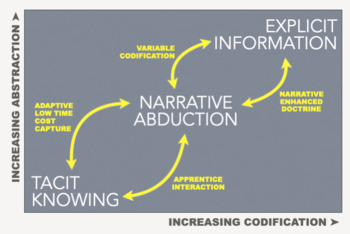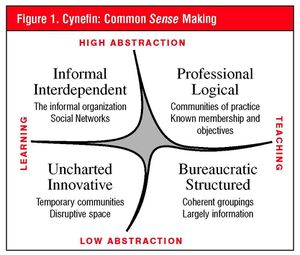Abstraction
Abstraction is a cognitive process consisting in isolating certain aspects of a given phenomenon or object, so as to relate it to other phenomena or objects showing the same common aspects. As such, abstraction is a dimension of context. In order to share meaningful knowledge it is important to understand different levels of abstraction. Meaningful knowledge sharing is meaningful communication. Meaningful communication is only possible within an acceptable zone of abstraction. The broader the range, the more expensive the cost of creating it is going to be. Scalability or high diffusion (of knowledge) only happens with high codification AND abstraction. If you just codify before the abstractions are established and evolved then integrity is lost.
Concept
Art comes before language in human evolution and our ability to see things through an abstract lens is key to our sense-making and to innovation. So by shifting interpretation to the abstract we increased the potential for meaning to emerge. Narrative is itself a form of abstraction.
Max Boisot developed the I-Space conceptual framework, which has three axes: abstraction, codification, and diffusion. Cynefin took the abstraction and codification aspects of the I-Space.

Core theory
High abstraction either involves expert language, taught in universities, through books, training programmes and so on, or shared experiential and cultural referents. Levels of abstraction are important for knowledge flow.
In practice there is a very narrow zone between the lower and upper levels of acceptable abstraction in any knowledge exchange. Expert communities resent any knowledge below the lower level as it involves reengaging in a level of conversation which they have passed some time ago – they will visit to teach, but not to collaborate. In contrast, a broad cross organisation community needs to ensure that it does not exceed the upper level – the lower level is of less importance. The upper and lower levels represent the range of shared context and therefore the range of possible knowledge flow.
The dimensions of abstraction and culture create the sense-making
Bureaucratic/structured – teaching, low abstraction. This is the formal organisation, the realm of company policy, procedures and controls. It is a training environment. Its language is known, explicit and open. It is the legitimate domain of the corporate intranet and its shared context is the lowest common denominator of its target audience’s shared context.
Professional/logical – teaching, high abstraction. Commonly professional individuals, who through defined training programmes, acquire a specialist terminology – codified in textbooks. The high level of abstraction is teachable given the necessary time, intelligence and opportunity. This is one of the most important domains as knowledge communication is at its most efficient due to the high level of abstraction – in second generation thinking this is the domain of communities of practice.
Informal/interdependent – learning, high abstraction. In this domain we have the abstraction of shared experiences, values and beliefs. This is the domain of the shadow or informal organisation, that complex network of obligations, experiences and mutual commitments without which an organisation could not survive. Trust in this domain is a naturally occurring phenomenon as all collaboration is voluntary in nature. Examinations of primitive symbolic or pictorial languages reveal some relevant facts. Primary among these is the ability of symbolic languages to convey a large amount of knowledge or information in a very succinct way. Each symbol has a different meaning according the combination of symbols that preceded it. The problem is that such languages are difficult to comprehend and near impossible to use unless you grow up in the community of symbol users. In some primitive societies the symbols are stories, often unique to a particular family who train their children to act as human repositories of complex stories that contain the wisdom of the tribe. The ability to convey high levels of complexity through story lies in the highly abstract nature of the symbol associations in the observer’s mind when she/he hears the story. It triggers ideas, concepts, values and beliefs at an emotional and intellectual level simultaneously. A critical mass of such anecdotal material from a cohesive community can be used to identify and codify simple rules and values that underlie the reality of that organisation’s culture, (Snowden 1999b). At its simplest manifestation this can be a coded reference to past experience. ‘You’re doing a Margi’ may be praise or blame – without context the phrase is meaningless, with context a dense set of experiences is communicated in a simple form.
Uncharted/innovative – learning, low abstraction. We now reach a domain in which we have neither the experience, nor the expertise because the situation is new, the ultimate learning environment. The organisation will tend to look at such problems through the filters of past experience. The history of business is littered with companies who failed to realise that the world had changed. In hindsight such foolishness is easy to identify, but at the time the dominant language and belief systems of the organisation concerned make it far from obvious. This is particularly true where the cost of knowledge creation within the organisation is high as this tends to knowledge hoarding and secrecy that in turn can blind the organisation to new and changed circumstances. Other organisations deliberately share knowledge, depending on speed of exploitation as the means of maintaining competitive advantage, (Boisot 1998). Here we act to create context to enable action, through individuals or communities who have either developed specific understanding, or who are comfortable in conditions of extreme uncertainty. Such individuals or communities impose patterns on chaos to make it both comprehensible and manageable.
Supporting artefacts
Any training material, posters and like with links to where they can be acquired
References
Link to other articles on this wiki if they are relevant
Articles
Blog posts
https://www.cognitive-edge.com/narrative-as-abductive-acts-of-knowing/
Related concepts
- Knowledge management
- Knowledge mapping
- Exaptation
- I-Space (framework)
Cases
Link to case articles here or third party material
